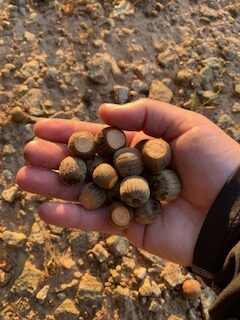
To eat or not to eat? Finding edible items in nature
Savannah Williamson, Staff Writer
You’re out in the woods, and you’re starting to get hungry. Alas, you didn’t bring anything to eat. But never fear, there are plenty of plants and edible items in nature that are safe to eat. Here is a short list of some autumn plants that are perfectly edible and pretty tasty.
- The Eastern Black Walnut Tree (Juglans Nigra)
The Eastern Black Walnut Tree is a hearty tree. The walnuts themselves are slightly sweet and have an earthy taste that pairs really well with sweets. They can be eaten raw, or heated over a fire to bring out a richer taste. Be mindful, however, to just eat the flesh of the walnut. The shell and the outer covering contain tannin. It can stain your fingers, and make you physically ill.
- Roses (Rosa)
Roses smell amazing, look absolutely gorgeous and are incredibly tasty. Roses have a nice aromatic smell and a deep floral flavor that is slightly sweet. The petals can be washed and eaten by themselves or thrown into a salad for a little extra sweetness. The petals and the bulb that forms under their stem, called a rosehip, can be boiled and made into a delicious tea. You can also put sugar into a hot pot with some water and corn syrup and add in some rose petals for a sweet rose cordial.
- Willow (Salix)
Willow trees are gorgeous and they are edible. Willow leaves can be washed and eaten raw, however, they are bitter. Willow bark and willow buds are less bitter and can be boiled for a fever reducing and pain relieving tea. Willow is a natural antiseptic and pain reliever. It is considered a famine plant (or an emergency edible plant) because it is bitter, but it has beneficial health benefits if it is consumed.
- Juniper/Red Cedar (Juniperus)
Juniper is a hardwood that is normally seen around Christmas. It’s an evergreen tree, and in the early fall, before the first frost, the tree puts off blue berries. The berries are used in small batches to flavor food and they should be treated like a spice due to their heavy pine-like flavor. The needles are also edible, but they are mainly used for teas because they contain a high amount of vitamin C.
- Blueberries (Wild/High Bush) (Vaccinium Corymbosum)
Blueberries, a classic treat for many people. They are rich in antioxidants, vitamins and minerals. They also have no cholesterol or saturated fat, and they are low in calories. However, a wild blueberry bush may look a little different. It grows more like a tree, and it can produce blueberries up until the first frost. The berries from a wild blueberry bush are generally smaller but they are sweeter. The amount time for their production is nearly double for a farm maintained blueberry bush.
- Purple Aster (Symphyotrichum Patens)
Purple aster is a late season flower that has a fragrant smell. It has a close relative flower, the daisy, which is also edible, but the asters are sweeter. The flowers can be eaten by themselves, and the leaves can be stripped, washed and put into a salad for a mild bitter taste. Aster flowers with a little bit of powdered sugar sprinkled on top is a little fall treat. This treat has the earthiness of the flower that offsets the sweetness of the powdered sugar for a combination. Asters are also used as decorations for cakes, because of how they are edible and visually appealing.
- Oak Tree/Acorns (Quercus)
The oak tree is commonly used for its wood, but it has one of the most plentiful food sources that is edible. Acorns are used for a lot of things. From roasting them and eating them with salt, to mixing them with oil to make acorn butter, there are multiple of uses for acorns. However, when consuming acorns you have to make sure you harvest the brown ones, and you have to remove tannin from them if you want them to be food safe. The quickest way to remove tannin is to bring water to a boil and dump the acorns into the water and boil them for 15 to 20 minutes. You will want to boil them until the water is the color of tea. Then you dump out the water, and repeat the process two to three more times. Then you have food-safe acorns and a healthy snack.
- Chickens (Gallus Gallus Domesticus)
I had to throw in something to earn a laugh so here we have the domesticated chicken. Chickens are used primarily for their meat and egg production, which are both highly safe and edible for humans. However, the chickens down below have been attacked by the rowdy Chick-Fil-A cows and their shenanigans. They always want to encourage NGU students to “Eat Mor Chikn”.
